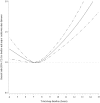Association of estimated sleep duration and naps with mortality and cardiovascular events: a study of 116 632 people from 21 countries
- PMID: 30517670
- PMCID: PMC6528160
- DOI: 10.1093/eurheartj/ehy695
Association of estimated sleep duration and naps with mortality and cardiovascular events: a study of 116 632 people from 21 countries
Abstract
Aims: To investigate the association of estimated total daily sleep duration and daytime nap duration with deaths and major cardiovascular events.
Methods and results: We estimated the durations of total daily sleep and daytime naps based on the amount of time in bed and self-reported napping time and examined the associations between them and the composite outcome of deaths and major cardiovascular events in 116 632 participants from seven regions. After a median follow-up of 7.8 years, we recorded 4381 deaths and 4365 major cardiovascular events. It showed both shorter (≤6 h/day) and longer (>8 h/day) estimated total sleep durations were associated with an increased risk of the composite outcome when adjusted for age and sex. After adjustment for demographic characteristics, lifestyle behaviours and health status, a J-shaped association was observed. Compared with sleeping 6-8 h/day, those who slept ≤6 h/day had a non-significant trend for increased risk of the composite outcome [hazard ratio (HR), 1.09; 95% confidence interval, 0.99-1.20]. As estimated sleep duration increased, we also noticed a significant trend for a greater risk of the composite outcome [HR of 1.05 (0.99-1.12), 1.17 (1.09-1.25), and 1.41 (1.30-1.53) for 8-9 h/day, 9-10 h/day, and >10 h/day, Ptrend < 0.0001, respectively]. The results were similar for each of all-cause mortality and major cardiovascular events. Daytime nap duration was associated with an increased risk of the composite events in those with over 6 h of nocturnal sleep duration, but not in shorter nocturnal sleepers (≤6 h).
Conclusion: Estimated total sleep duration of 6-8 h per day is associated with the lowest risk of deaths and major cardiovascular events. Daytime napping is associated with increased risks of major cardiovascular events and deaths in those with >6 h of nighttime sleep but not in those sleeping ≤6 h/night.
Keywords: Cardiovascular diseases; Mortality; Naps; Sleep duration.
Published on behalf of the European Society of Cardiology. All rights reserved. © The Author(s) 2018. For permissions, please email: journals.permissions@oup.com.
Figures



Comment in
-
Sleep and cardiovascular risk: how much is too much of a good thing?Eur Heart J. 2019 May 21;40(20):1630-1632. doi: 10.1093/eurheartj/ehy772. Eur Heart J. 2019. PMID: 30517630 No abstract available.
-
Napping: is it really a means by which short sleepers can have their cake and eat it too?J Emerg Crit Care Med. 2019 May;3:24. doi: 10.21037/jeccm.2019.05.02. Epub 2019 May 21. J Emerg Crit Care Med. 2019. PMID: 34113779 Free PMC article. No abstract available.
References
-
- Qureshi AI, Giles WH, Croft JB, Bliwise DL.. Habitual sleep patterns and risk for stroke and coronary heart disease: a 10-year follow-up from NHANES I. Neurology 1997;48:904–911. - PubMed
Publication types
MeSH terms
Grants and funding
LinkOut - more resources
Full Text Sources
Research Materials

